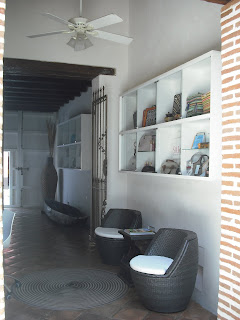 Beth and I taking a break from cooking our Thanksgiving dinner in Colombia.
Beth and I taking a break from cooking our Thanksgiving dinner in Colombia.*Melody steps onto her soapbox*
Living abroad is a wonderful experience, and I highly support anyone who ever decides to try it. It doesn't matter where you go or what you're doing (okay, it does a little), living abroad can be highly rewarding. The numerous benefits of living abroad highly outweigh the losses of giving up time at home, but sometimes it becomes easy to forget this. Primarily around holidays.
I'm lucky this year because I am going home for Christmas, and I went home for the Fourth of July (basically my two favorite holidays) but I did spend Halloween, Thanksgiving, Easter, and Warren's birthday here, and those rank as major holidays in my life. When I lived in Denmark, I spent Halloween, Thanksgiving, Christmas, my birthday, and New Year's Eve/Day in Europe. Holidays tend to be when people get homesick because it is strange to be so far away in such a foreign and odd environment when your family or friends are at home, doing things the way you have always done them. Because of this, I'm giving you my recommendations about how to enjoy holidays abroad. Here goes...
1. Don't pretend there isn't a holiday. Stay in touch with what is going on, because feeling like you are involved is much better than feeling isolated and lonely. Call your family and friends and talk to them. I prefer to do this at crucial moments in the holiday (opening presents on Christmas, finishing or beginning the Thanksgiving meal, etc.). With the advent of Skype, everybody with a webcam on both ends of the conversation can basically be "there" if that's what they really want.
2. Don't spend holidays abroad alone. Celebrate them with friends. If you are the only person from your culture living where you do, invite the locals to share the holiday with you. Explain all the traditions and let them enjoy it with you. We did this on Halloween in Denmark (carving pumpkins, having a little trick-or-treat in our kollegium), and everyone loved it. Of course, it's always better if you have at least one other person from your culture around, because it makes it easier to share the day and make it feel special.
3. Incorporate part of the local culture into the holiday. For us, this Thanksgiving it meant giving a plate of food to our portero. In Denmark we made traditional Christmas ornaments and drank Glogg (mulled wine). Take pictures, too. This will help you create memories for the future. Although I've celebrated many Thanksgivings, the ones I've spent abroad were incredibly special, and I treasure those memories.
4. Do the best you can to recreate the holiday where you are, but don't stress out about getting every detail perfect. For example, we were able to have a pumpkin pie at our Thanksgiving in Colombia because Beth roasted a whole pumpkin and didn't stress about not having canned pumpkin. We did not have a whole roasted turkey that we carved at the table because our oven wasn't big enough and there were only 3 meat-eaters. (Besides, apparently braised turkey tastes better anyway!) Some holidays are easier to recreate than others, and some places are easier to recreate those holidays than others, and you just have to accept that you can't make it the same as home. Instead, make your alterations part of the holiday, and they will become part of that special memory.
5. If the holiday is celebrated in the local culture (albeit in slightly different ways), enjoy that part of the holiday, too. In Denmark, celebrating Christmas was fun because we got to experience a completely different set of traditions. For example, although I didn't get to witness it in person, Danish people sing and dance while circling the Christmas tree. My friend video taped his family doing this, and although I thought it was hilarious, it was a special part of his Christmas traditions. Many of the traditional foods served vary from country to country, and this is definitely something special to try. In Colombia, Natilla is a special dessert served around Christmas, and the boxed mix for it has appeared in every grocery store in Pereira. This is the sort of thing adventurous eaters should always go for.
Okay, that's all! Happy holidays to everyone, whether you are at your home, living abroad, or traveling. Keep up those cultural traditions!



















































